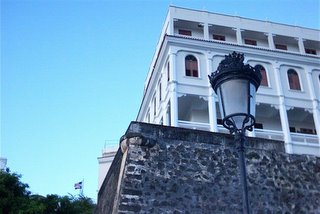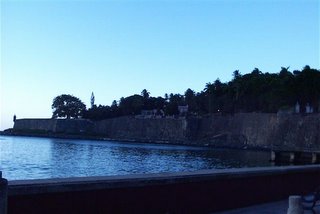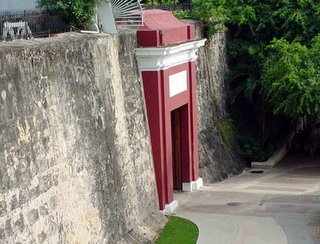I am hoping that this blog will help you and me experience the craft of crochet as well as knitting. During times of silence or turmoil, crochet and knitting continuously help me quiet my mind at my own pace, enabling me to find my center. I am also sharing my SECRET persona, Lt. DAX, my life in code while living in Bajor. Maybe fiction maybe not is up to you to decide. Peldor Joi!!!
Thursday, December 01, 2011
Culebra Holiday
Friday, November 25, 2011
A bit of History
Thursday, November 24, 2011
Happy Thanksgiving 2011
This year we went to Puerto Rico to spend the Thanksgiving Holiday and defrost for a change. I was fortunate to be able to spend a Thanksgiving with some family. Michael came into the fold and embraced the dark side, he is part of the family now. The picture above is in the old city of San Juan. This is a must do walk if yu come by. I also had a Glass of Mavi which I have not had in years. I have almost forgotten how good it tasted
Below Crafty Andy Nephew and Niece and my mother as elegant as always. She is such a sharp dresser and always wearing her jewerly and make up. She is like Marie Barrone from "Everybody Loves Raymond", in many ways, but today, she behaved like a saint. lol!
We were very fortunate to find a great restaurant with the ability to take a group of 10 for Thanskgiving, lots of places were closed for the Holiday. It has been the best Family Thanksgiving that I have had in my time. I was glad to see and spend time with my loved ones. The food was fantastic and the Sangria was very refreshing. I hope everyon had a good Thanksgiving and more to come , so stay tuned. Thanks for stopping by!
Tuesday, November 22, 2011
Knit or Crochet in Public
Here In the picture above you find me knitting in public. At the bottom you find me crocheting in public . I had to hide the item I am crocheting as it is the new hat that will be coming out soon. Tonight I went to Punto Reves again and what an experience. I enjoyed the company of the creative people that surrounded me. I am so glad that I found this place and I will tell you that I would go every day if I could. There is something wonderful happening here and I got so much inspiration. Thanks to CUca and Merce for their hospitality and fantastic Coffee. The coffee, the conversation, the sharing of ideas and techniques, it is really what Knitting and crocheting is about. Thanks for stopping by!
Sunday, November 13, 2011
Aibonito 2011
The Restaurant has a balconey with a view, a simple wine cellar and fantastic friendly staff. The shimmer at the horizon is the ocean or rather the Caribbean Sea. We are in the Middle of the Sierra that divides the Island North and South. I had some Chicken brest, grilled with rice and beans. My sister had Chuletas Can Can, and my niece and her boyfriend had a beef churrasco. My great niece had some chicken strips, the child size. We had a great time and the view was magnificent. Hope to share more of the journey with you as I get inspiration to creat a pattern or two. Thanks for stopping by.
Friday, May 22, 2009
KIP Carolina, Puerto Rico
.JPG) It is nice to be able to knit in Public no matter where you go, crochet for tat matter as you always get people that are curious about what you are doing. One of the most interesting things I have found is the ability of double point needles to attract the attention of people. I guess most people think of knitting on two needles or crochet with one hooked needle. Hope you are doing great and thanks for stopping by, more pictures to come> Thanks for stopping by.
It is nice to be able to knit in Public no matter where you go, crochet for tat matter as you always get people that are curious about what you are doing. One of the most interesting things I have found is the ability of double point needles to attract the attention of people. I guess most people think of knitting on two needles or crochet with one hooked needle. Hope you are doing great and thanks for stopping by, more pictures to come> Thanks for stopping by.Saturday, May 16, 2009
Knit in Public Quebradillas

Thursday, March 06, 2008
Tren Urbano de Puerto Rico

The Tren Urbano as it is called, or in English Urban Train. From Guaynabo's Torrimar to Piñero's Station in San Juan or Hato Rey Ward. Apologies for the gum Chewing, Itis a prescription gum and I forgot I was chewing, lol! Andy the Billy Goat!
The Tren Urbano complements other forms of public transportation on the island such as the public bus system, taxis, water ferries and shuttles. The entire mass transportation system has been dubbed the “Alternativa de Transporte Integrado” (Integrated Transportation Alternative) or “ATI”.
The Tren Urbano, Caribbean's first rapid transit system, has now has been joined by the new Santo Domingo Metro.
Sunday, March 02, 2008
San Felipe del Morro, San Juan Bay
This is not the best of videos, but it is me sharing with you. The sound sometimes gets very loud because of the wind, I apologize ahead of time. I am learning how to shield the caera from getting whipped by the wind and at times it works well lol! I was very happy to share part of my Sunday with you, dial up is very hard on videos of this size , it took me about two hours to upload it. There are more hope you like them all. Thanks for stopping by!
Monday, November 19, 2007
Monday, March 26, 2007
Arecibo Observatory et LightHouse 07
 The construction of the Arecibo telescope was initiated by Professor William E. Gordon of Cornell University, who originally intended to use it for the study of Earth's ionosphere. Originally, a fixed parabolic reflector was envisioned, pointing in a fixed direction with a 150 m (500 ft) tower to hold equipment at the focus. This design would have had a very limited use for other potential areas of research, such as planetary science and radio astronomy, which require the ability to point at different positions in the sky and to track those positions for an extended period as Earth rotates.
The construction of the Arecibo telescope was initiated by Professor William E. Gordon of Cornell University, who originally intended to use it for the study of Earth's ionosphere. Originally, a fixed parabolic reflector was envisioned, pointing in a fixed direction with a 150 m (500 ft) tower to hold equipment at the focus. This design would have had a very limited use for other potential areas of research, such as planetary science and radio astronomy, which require the ability to point at different positions in the sky and to track those positions for an extended period as Earth rotates.The Arecibo telescope has made many significant scientific discoveries. On 7 April 1964, shortly after its inauguration, Gordon H. Pettengill's team used it to determine that the rotation rate of Mercury was not 88 days, as previously thought, but only 59 days. In 1968, the discovery of the periodicity of the Crab Pulsar (33 ms) by Lovelace and others provided the first solid evidence that neutron stars exist in the Universe. In 1974 Hulse and Taylor discovered the first binary pulsar PSR B1913+16, for which they were later awarded the Nobel Prize in Physics. In 1982, the first millisecond pulsar, PSR J1937+21, was discovered by Don Backer, Shri Kulkarni and others. This object spins 642 times per second, and it was until 2005 the fastest-spinning pulsar known.

A report by the National Science Foundation, made public on 2006-11-03, recommended decreased funding for Arecibo Observatory. If other sources of funding cannot be obtained, the telescope will be shut down in 2011. The report also advised that 80% of the observation time be allocated to the surveys already in progress, reducing the time available for other scientific work. If the report's recommendations are followed, Arecibo's radar astronomy program will cease October 1 2007.

The telescope also had military intelligence uses, for example locating Soviet radar installations by detecting their signals bouncing back off of the Moon. Arecibo is also the source of data for the http://www2.blogger.com/wiki/SETI_at_home distributed computing project put forward by the Space Sciences Laboratory at the University of California, Berkeley and was used for the SETI Institute's Project Phoenix observations.
In 1974, the Arecibo message, an attempt to communicate with extraterrestrial life, was transmitted from the radio telescope toward the globular cluster M13, about 25,000 light-years away. The 1,679 bit pattern of 1s and 0s defined a 23 by 73 pixel bitmap image that included numbers, stick figures, chemical formulas, and a crude image of the telescope itself.
Terrestrial aeronomy experiments include the controversial (Ruiz 1998) Coqui 2 experiment (Friedlander 1997).

It is located 18º 29' North, 66º 41.9' West, on the North Coast of Puerto Rico, 34 miles West of San Juan. This was the last lighthouse built by the Spanish government in 1898. The style of construction is neo-classical with a rectangular shape of 40'4" (12.30 mts) wide by 84'2" (25.64 mts) long, and has attached a hexagonal tower covered by a bronze dome with a working lantern. The original lens was a third order Fresnel, with an 18 mile radius. At the present time it has a 190mm lens with a white flash every 5 seconds.
It is also known as "Morrillo's Lighthouse" because it is located on top of a rocky mountain known as "Punta Morrillo". In the interior of the lighthouse, you will be able to observe artifacts found at the bottom of the ocean, a 1910 diving suit, a replica of the US Constitution and on its wall literature relating to the history of the Arecibo Lighthouse and the Spanish-American War

Welcome to the Spanish Conquest representation. Here you will find the Niña, the Pinta and the Santa María built at one-third of its original size. All ships are ready to be boarded. Here you will appreciate its design, different types of food used on those trips across the ocean and learn a little bit more about Christopher Columbus's life. At the top we can see the lighthouse.

Arecibo (ah-re-SEE-boh) is a municipality in the northern midwest coast of Puerto Rico and located by the Atlantic Ocean, north of Utuado and Ciales; east of Hatillo; and west of Barceloneta, and Florida. Arecibo is spread over 18 wards and Arecibo Pueblo (The downtown area and the administrative center of the city). Arecibo is located on the north coast of the island of Puerto Rico, about 80 kilometres (50 miles) west of San Juan, or approximately a 1-hour trip by car.
Arecibo, settled in 1556, was the island's third Spanish settlement, after Caparra (which later became San Juan), and San German. It is named after the Taíno Cacique Xamaica Arasibo, who ruled the Taino yucayeke (town), then named Abacoa. Arecibo was officially founded as a city by the Spanish crown May 1 1616, under the governorship of Captain Felipe de Beaumont y Navarra, when the King of Spain granted the land (and the Tainos living there) to Lope Conchillos.

Here is the Church in the town's Plaza. When you arrive to any Spanish town you know you have reached the Center because you find the Plaza surrounded by the church and the Mayor's Office.

Here is the Patron Saint of Arecibo San Antonio de Padua or Saint Anthony of Padua (Lisbon, August 15, 1195 – Padua, June 13, 1231), also venerated (particularly in Portugal and Portuguese-speaking countries) as Saint Anthony of Lisbon (Santo António de Lisboa), is a Catholic saint who was born in Lisbon, Portugal as Fernando de Bulhões (pron. IPA [fɨɾ'nɐ̃du dɨ bu'ʎõĩʃ]) to a wealthy family and who died in Padua, Italy. Today he is one of the most famous saints and is often called upon by Catholics to help find lost possessions. Other say that if you are looking for love you hang the Saint upside down until you find the love of your life. Legend from the old times , but you may try it and see.

Thanks for stopping by and come back as we continue our travellings through the Island of Enchantment, Puerto Rico.
Thursday, March 08, 2007
The Old City of San Juan 2007

Looking at this statue, the Statue of Cristobal Colon, aka Christopher Columbus. I never figured it out . How can he have two names, as names are not supposed to be translated, but who cares 500 years after. I used to go to the old city almost every week. Sometimes I would go two to three times a week

When you come to the city of San Juan Bautista, you will enter with the Fort of San Cristobal to your right . When you look to the front you will see Cristobal Colon up high on this pedestal. It has been there at least since I can remember, and about 40 years or more.
The Castillo de San Cristóbal is a Spanish fort in San Juan, Puerto Rico. It was built by the Spaniards to protect against land based attacks on the city of San Juan. It is part of San Juan National Historic Site.
Castillo de San Cristóbal is the largest fortification built by the Spanish in the New World. When it was finished in 1783 it covered about 27 acres of land, basically wrapping the city of San Juan. Entry to the city was sealed by San Cristóbal's double gates. After close to one hundred years of relative peace in the area, part of the fortification (about a third) was demolished in 1897 to help ease the flow of traffic in and out of the walled city.
 Above you will see one of Old San Juan's Cobblestone streets and it's picturesque facades.
Above you will see one of Old San Juan's Cobblestone streets and it's picturesque facades.
Here above you will find de San Juan Bautista Cathedral in Old San Juan . The Cathedral of San Juan Bautista is a cathedral in Old San Juan, Puerto Rico.
San Juan Bautista Cathedral
151 Cristo St
PO Box 9022145
San Juan, PR 00902
Phone: (787) 722-0861
A Cathedral of The Roman Catholic Archdiocese of San Juan
The cathedral is one of the oldest buildings in San Juan, and is the second oldest cathedral in the Western Hemisphere; construction began in 1521Below is the tomb where Juan Ponce de Leon is preserved. Juan Ponce de León (c. 1460 – July 1521) was a Spanish conquistador. He was born in Santervás de Campos (Valladolid). As a young man he joined the war to conquer Granada, the last Moorish state on the Iberian peninsula. Ponce de León accompanied Christopher Columbus on his second voyage to the New World. He became the first Governor of Puerto Rico by appointment of the Spanish Crown.

In 1521 Ponce de León organized a colonizing expedition on two ships. It consisted of some 200 men, including priests, farmers and artisans, 50 horses and other domestic animals, and farming implements. The expedition landed on the southwest coast of Florida, somewhere in the vicinity of the Caloosahatchee River or Charlotte Harbor. The colonists were soon attacked by Calusas and Ponce de León was injured by a poisoned arrow to the shoulder. After this attack, he and colonists sailed to Havana, Cuba, where he soon died of the wound. His tomb is in the cathedral in Old San Juan.


Well nothing else to say for now. I will try once more to upload pictures of my voyage to the town of Arecibo and some of it's landmarks. Arecibo (ah-re-SEE-boh) is a municipality in the northern midwest coast of Puerto Rico and located by the Atlantic Ocean. In the meantime , Salud!
Wednesday, January 31, 2007
Still here on Vacation for a while

I will be away for a while I will be posting pictures of the places I visit. Thanks for stopping by. This picture is from the "Capilla Del Cristo" in the old city of San Juan. Located at
Thanks for stopping by.
Saturday, April 22, 2006
Mundillo or Bobbin Lace

In English it is known as bobbin lace. In Puerto Rico this delicate handwork, used to embellish collars and handkerchiefs, bridal veils and baby bonnets, is encaje de bolillos but more commonly known as mundillo—"little world," for the cylinder on which the lace maker weaves her intricate designs.
On September 19, 2003, Rosa Elena Egipciaco of New York City was honored for her mundillo. She is one of sixteen artists to receive National Heritage Fellowships from the National Endowment for the Arts. The fellowships are the country’s highest honor in the folk and traditional arts. The awardees, chosen their artistic excellence, authenticity, and contributions to their field, each receive a one-time award of $20,000.
"We are proud to honor these master artists whose compelling work demonstrates the extraordinary diversity and depth of our nation’s cultural wealth," said Dana Gioia, chairman of the National Endowment for the Arts. "These talented individuals are not only renowned practitioners of their art forms but also teachers and preservers of artistic heritages, passing on their skills and passions to future generations."
Rosa Elena Egipciaco demonstrates mundillo at the Centro Civico festival in Amsterdam, New York. Photo: Elena Martínez
The importance of teaching traditional arts is apparent in the case of Rose Elena Egipciaco, who started learning mundillo at the age of four from her mother, Doña Salud, in Puerto Rico, and has taught and promoted the art in New York since 1986. In Puerto Rico, the towns of Moca, Isabela, and Aguadilla, all in the northwestern part of the island, are famous for mundillo. Moca, Egipciaco’s hometown, is considered la cuna (the cradle) of mundillo. When Egipciaco was a little girl playing house with her friends on the patio, she would design patterns on leaves, using thorns from a bush as needles. As she grew older, she would gather with friends on the balcony of one of their homes to talk, watch the boys pass by, and make mundillo.
When she was president of the Cultural Center in Moca (which she cofounded), Egipciaco traveled throughout the island, giving lectures on mundillo at festivals, universities, and colleges. She is a certified artisan through the Instituto de Cultura Puertorriqueña, the principal arts and cultural agency on the island, and has displayed her work at their festivals. In 1986 she moved to New York City and has taught lacemaking , as well as exhibited and displayed her work at New York University, Columbia University, the American Museum of Natural History, Casita Maria, El Museo del Barrio, Marymount College, Brentwood International Ladies Garment Union, the Office of the Commonwealth of Puerto Rico, and La Casa de la Herencia Cultural Puertorriqueña. She is currently a professor at Boricua College in Brooklyn, and an apprenticeship grant funded by the New York State Council on the Arts Apprenticeship Program enables her to continue teaching privately in Manhattan.
Origins of the Art
There are two types of lace: point, which is made using a needle, and bobbin, or pillow lace. Bobbin lace was first made in the Middle Ages in Flanders (the northern region of Belgium), where it was known as kant ("border" or "edge"), since the original function of lace was to protect the edges of fine materials from fraying, as well as to create a decorative border. The art of making bobbin lace may have reached Spain through Flanders or Italy. Some researchers believe that point lace was introduced to Spain from Italy and from there was brought to Flanders, which in the sixteenth century was one of Spain’s dominions. Bobbin lace, like the art of making it, was then exported to Spain and later to Puerto Rico.
Since making lace by hand is time consuming, it was very expensive and regarded as a luxury item. The Church was the principal consumer for lace for the veils and cloths used during services, as well as for the robes that adorned the statues of saints. During the sixteenth and seventeenth centuries, clothes with lace decoration came into fashion for both men and women of the European nobility. In Spain bobbin lace was made by master lace makers for major commercial markets; lace making was also a cottage industry in places like Mugía in Galicia, Almagro in Castilla, and Arenys de Mar in Catalonia.
In addition to its use as edging and borders on clothing and handkerchiefs and collars for shirts, mundillo is also used to decorate items for special occasions, such as wedding dresses, baptismal gowns, and the cloths used to adorn religious icons. Once it was common for lovers to exchange mundillo lace with romantic inscriptions.
Festival del Mundillo - Moca
787-818-0105, 787-877-0540, 787-877-3560FX
11/24/2006 - 11/26/2006
Plaza de Recreo de Moca
I wanted to share this article with you, Thanks for stopping by.
Saturday, January 21, 2006
Puerto Rico Vacation Part Six


Time seemed to stop while I was on that rock. I was just engulfed in the pure hedonistic pleasures of indulgence with the environment. I was one with the waves and the rocks, the sands and I were one. It was like the sand knew what it was to be sea and the sea knew what it was to be sand. My life was been shown on a movie screen as I evaluated my life till that day. I was pleased. I could meet my Gods in peace if that was the case. Living without regrets and without attachments, it takes time to learn to do that.
From the morning untill the night I embraced the Sea and the Sand every day I could. I did not overdo the sun. That night here I was at the balcony on the 14th floor, there is no 13th floor in that building. If you got out on the 13th floor you definitely stepped into the Twightlight Zone.
 I had a great time and wish I was not alone. Nevertheless I am very comfortable being by myself and enjoying life's little pleasures. Life's illusions and creative sceneries. During my visit I saw a friend from High School which I have not seen in almost 30 years. That's a longtime not seeing someone . We were talking about our class reunion for 2008 which will be our 30th reunion. Here she is Karina and yours trully. We talked about past class reunions and about the future class reunion. Some of our classmates have passed on to spirit, so they will not be physically present. Some of the other guys and gals are struggling with their health as am I, but they don't really know yet what it is I am struggling with. In their eyes I am retired that's it. From the ARMY I learned to use the "Need to Know Basis" for disclosing information. It is not a secret we hispanics are very nosey and disclose more information thatn needed. In the plane the senior couple that sat beside me almost gave me their address, where they have money in their house and how secure it was. People are very naive. On the other hand talking about peers, AIDS has a strange effect on people. I have seen people that were very eager to rekindle a friendship with me until they know how I got infected. They can deal with the disease, but not with the way of transmision which in my case if through being gay or more explicitly gay sex LOL.
I had a great time and wish I was not alone. Nevertheless I am very comfortable being by myself and enjoying life's little pleasures. Life's illusions and creative sceneries. During my visit I saw a friend from High School which I have not seen in almost 30 years. That's a longtime not seeing someone . We were talking about our class reunion for 2008 which will be our 30th reunion. Here she is Karina and yours trully. We talked about past class reunions and about the future class reunion. Some of our classmates have passed on to spirit, so they will not be physically present. Some of the other guys and gals are struggling with their health as am I, but they don't really know yet what it is I am struggling with. In their eyes I am retired that's it. From the ARMY I learned to use the "Need to Know Basis" for disclosing information. It is not a secret we hispanics are very nosey and disclose more information thatn needed. In the plane the senior couple that sat beside me almost gave me their address, where they have money in their house and how secure it was. People are very naive. On the other hand talking about peers, AIDS has a strange effect on people. I have seen people that were very eager to rekindle a friendship with me until they know how I got infected. They can deal with the disease, but not with the way of transmision which in my case if through being gay or more explicitly gay sex LOL.
Thursday, January 19, 2006
Puerto Rico Vacation Part Five
 This building atop this city wall that you see here is the Governor's Mansion or "La Fortaleza", The Fortress. San Juan was founded in 1521, the city is one of the most beautiful cities that I have ever seen in the world. It's the city I called home and so many wonderful memories.
This building atop this city wall that you see here is the Governor's Mansion or "La Fortaleza", The Fortress. San Juan was founded in 1521, the city is one of the most beautiful cities that I have ever seen in the world. It's the city I called home and so many wonderful memories.


 ed your invasion at the right time.
ed your invasion at the right time.Almost two years without blogging August 2020
Life can be a bowl of strawberries when cheries are not available. It has been almost two years since I have been in this blog. I have s...

-
Well I am doing this in a public way , because I found at least four people that have been hit with this. The headline was "Credit Card...
-
The Prisoner of Azkaban Hogwarts scarves are very different from the old scarves where egalitarian stripes where the norm. I have created a...
-
Life can be a bowl of strawberries when cheries are not available. It has been almost two years since I have been in this blog. I have s...
.jpg)

